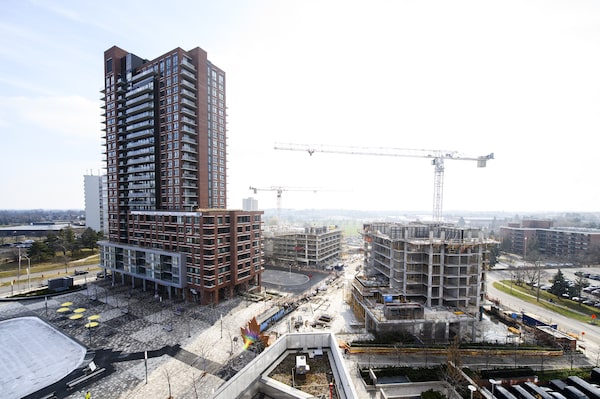
Condo construction is shown in Ajax, Ont., on Nov. 30, 2023.Christopher Katsarov/The Canadian Press
As governments at all levels grapple with the housing crisis in Canada evidence is building that new home buyers and builders won’t be bailing out the country with a pile of new supply.
Sean Fraser, the federal Minister of Housing seems to be everywhere, announcing new money for housing or arguing with municipalities or provinces about the right incentives to unlock development.
But private actors are suggesting the tide is flowing in the opposite direction of the federal housing goal to get 3.87 million new homes built by 2031.
Data presented in an annual report from Ontario’s new home warranty insurer Tarion based on a survey performed in late 2023 by Environics suggest that as many as 250,000 potential new home buyers dropped out of the market compared with 2022. Overall, 34 per cent fewer people are considering buying a new home survey respondents said, listing size, price and style as the key elements of their decision. The most negative in the market – those who consider themselves “not likely at all” to buy a new home – rose from 7 per cent to 11 per cent of respondents.
The research company did not provide a margin of error for the poll – an online survey of 538 Ontario residents – making it difficult to gauge the importance of small shifts in the results compared with 2022 data.
Tarion’s tally of new preconstruction sales was more stark: In 2022 there were 73,383 new homes sold, but in 2023 the number dropped 25 per cent to 54,352. Things have only gotten worse this year.
“Year to date in 2024, condo enrolments are way down,” says Peter Balasubramanian, president and chief executive officer of Tarion. “To the end of March in 2023 there were 15,000 condo enrolments: in the same period this year we’re at 6,500.” A drop of 43 per cent in the traditionally busy spring launch period is dramatic and if the trend continues 2024 could end up looking a lot like some of the worst years in new home sales of the 1980s.
“There have been moments in history when enrolments were really low,” Mr. Balasubramanian said. “In the 1980s they were about 20,000 a year … in the last 10 years, it was closer to 60,000.”

Very little signage denotes the Mirvish Village development under construction in Toronto at Bloor and Bathurst, the former site of Honest Ed’s discount store.Melissa Tait/The Globe and Mail
The slide in new home sales appears even steeper in the Greater Toronto Area. April figures from market researcher Urbanation Inc. showed just 1,461 condominium sales in the first quarter of 2024: “Sales were down 71 per cent when compared to the latest 10-year average for Q1 periods [4,978 sales], dropping 85 per cent from the Q1 high in 2022 [9,723 sales].”
An oft-mentioned factor in the Toronto-area market’s sales slowdown is perhaps the most obvious: price. Outside of Toronto, the per square foot price for new homes in the first quarter hit $1,161, while inside Toronto’s boundaries the prices fell four per cent to $1,522 per square foot.
Ten years ago, the first quarter of 2014 saw new condos sell for an average of $549 per square foot. The question buyers have to ask is if the condos they are looking at now are 177 per cent better than they were a decade ago.
According to David MacDonald, a vice-president at Environics Research, “Canadian consumer confidence is at one of its lowest points since the financial crisis of 2009.”
The good news comes from a new report published by Mathieu Laberge, a senior vice-president for housing economics and insights at the Canada Mortgage and Housing Corporation. He argues that Canada is more than capable of physically building the homes we need.
“There’s never been more workers and rarely been more money in the system for housing,” said Mr. Laberge. The approximately 240,000 housing starts in 2023 was 70 per cent lower than the 400,000 starts he believes is possible.
Mr. Laberge arrives at that number of potential housing starts by looking at what were historically the best years in the country’s best house-building markets, like Vancouver and Calgary, and averaging them over about 20 years. His calculations assume construction labour productivity at pre-2004 levels, but if new technologies like prefabricated home building reach wider adoption, housing starts could climb close to 500,000 a year.
He also argues that innovation that make homes cheaper for buyers doesn’t mean builders will make less money.
“If [buyers] can’t afford it, the answer is not to wait until they can,” he said. “If you start to do things differently and you bring more affordable options, the market will start growing … you’ll have more demand. This is the concept of suppressed demand.” It’s economics 101: expanding a market even at lower prices means the benefits accrue to the company gaining new customers.
Mr. Laberge also has a warning for governments that stand in the way of solutions that can deliver more new homes cheaper: “We’re in a crisis; when outcomes don’t follow, social acceptability goes down. Canadians will start asking why we don’t see better outcomes.”